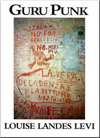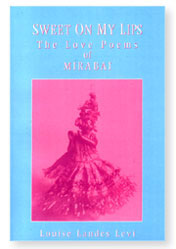What made you want to translate Mirabai?
I went to the University of California, Berkeley in the l960's. There was a Poetic Renaissance in San Francisco and a socio–political climate which encouraged innovation, especially of the mind and the spirit. I was drawn to India, and involved in Indian music, through a geographical coincidence: Ali Akbar Khan's school opened in Berkeley at the same time that my interests in music shifted to improvisation and performance. Intuitively I knew that Kabir and Mirabai were the poets I wanted to study. I was interested in 'spiritual' practice and the poetry that accompanied it. I felt that in order to 'find my own voice' I had to first understand the 'voice' of a great devotional poet like Mirabai.
In other words: to avoid Imitation, I wanted and needed to understand. Besides, due to a certain frailty &/or latent or concealed mental 'illness' I could not to use drugs, the gate to certain kinds of consciousness–expansion in that time. So I turned to a still inarticulate idea of practice and I knew that in India certain states were celebrated in certain traditions directly through poetic practice. The Great Berkeley Poetry readings and Allen Ginsberg's chanting at one of these alerted me to an ecstatic tradition which I wanted to explore directly. Later, in India, I learned the Devanagari (or Sanskrit) alphabet through a non-dual or direct process and translation from texts in this alphabet, or related to it, became a vehicle of that exploration.
You imply that Mira was liberated. What is the difference in the understanding of a liberated person in the east and the west?
I can only answer subjectively, from my own studies and experience. In general, in the West, we think of liberation in terms of social, economic, even personal factors, all which relate to the 'I', to the nature of our ego bound fields of interest and perception. In the East, at least in Buddhist schools and their indigenous predecessors in Tibet, India, Nepal et al., to be liberated implies a liberation from the concept of 'I' or 'self' or an ego–bound perception of reality. One is liberated from the appearance of reality and released into a world in which the ego is no longer the center of ones reference point. Of course, one can not know these states through the mind, so I offer only my provisional understanding of them.
What does tantrism have to do with Mira's life and work?
In general, in India, at least, the Tantric schools refer to practices which are not included in the Vedic precepts and commentaries. The school of Bhakti or devotional love which flourished in India in the fifteenth and sixteenth centuries and produced dozens of brilliant poets—Mirabai was not the only one—resulted from factors which clearly separate it from the prevailing orthodoxy. Considerations of caste, conventional attitudes to love and seduction, the nature of emotion itself was revolutionized during this period. In the North East of India, in communities which survive today, for example in the Baul community, practices directly related to sexuality and the physical polarities between male and female disciples were used in the pursuit of liberation. Moksha in Sanskrit, like most words in the language, has complex variety of meanings. It is both liberation in a directly sexual sense, and liberation as explained above, in the mind. Vaishnavism, in North West India, of which Mira is a supreme exponent, did not refer directly to these practices. Instead, the polarity was, from what we understand, internalized and the great meetings reserved for the inner chakras and channels, which in the Tantric tradition are male and female, by nature, and whose unification internally, leads to this same non-dual liberation.
Does Mirabai's life have any relevence to people today?
The Industrial-Military complex, capitalism itself, with its underlying message that it is morally acceptable to use others for one's profit, offers the same challenge that the caste oriented, racially hierarchical and spiritually exclusive society of sixteenth century India did to its citizens. Mirabai and her contemporaries defied this order. Mirabai was from the warrior caste, her father and her grandfather were legendary warriors. Yet she and her contemporaries preached and practiced a non-violent revolution of caste and consciousness. They took a teachings to the streets that had been reserved for the white (fair-skinned/Brahminic) male priests and their constituents, for centuries.
I think, in some ways, the social revolution that occurred in the 6O's, however ineffective it may have been to deter certain aspects of the later half of the century, did suggest and invoke an individual freedom and a right to that freedom which is the property of the human heart and not the property of any government or institution of that government. Mira's realization can not be qualified by time and space. This realization resides innately in the human mind and can manifest today as it did in centuries which have passed. Mirabai of course was a woman. She was the only great female voice of the Vaishnavite tradition and she faced the same difficulties which are, in general, faced by women today who wish to free themselves from conventional cultural patterns and the expectations inherent in those patterns.
Is there a difference between translating this kind of poetry and the other authors (Rene Dauman and Henri Michaux) whom you have translated?
If you are talking about traditional and non-traditional forms of poetic activity, of course there is a difference. Mirabai's poetic is part of a tradition which exists in the sub-continent and which is devoted to maintaining an energetic potential which, in that tradition, is called transmission. It is believed that such literature has the power of sacred utterance or mantra and can directly alter the listener's or the reader's state of mind, initiating him or her into a higher field of consciousness.
This literature is at times canonized and given sacred signification. There is even a name reserved, in the tradition, for the language in which such texts are written, i.e.Sandhya Bhasa or Twilight Speech. The poetry of Saraha, the sixth Dalai Lama, Mirabai are a few historical examples.
We have this tradition in the West as well but it is less understood as such. This material requires an extremely responsible commitment from the translator, at least I see it this way. Although it may be impossible to translate this kind of activity, in which consciousness and language are directly merged, one's intention , one's recognition of the material, is of utmost importance. One is entering a lineage or enlightened tradition in which the word has served as a principle conduit. One has the same responsibility to a so-called ordinary author; if Enlightenment exists in the human mind stream like salt in water, then that consciousness permeates all forms of activity, naturally. But, in the case of realized beings, like Milarepa and Saraha or Surdas and Tulsidas, this relation is even more clear, and more subtle at the same time and demands a tremendous effort, that at the same time must be effortless in order to reflect the attainment of the so-called author in question.




